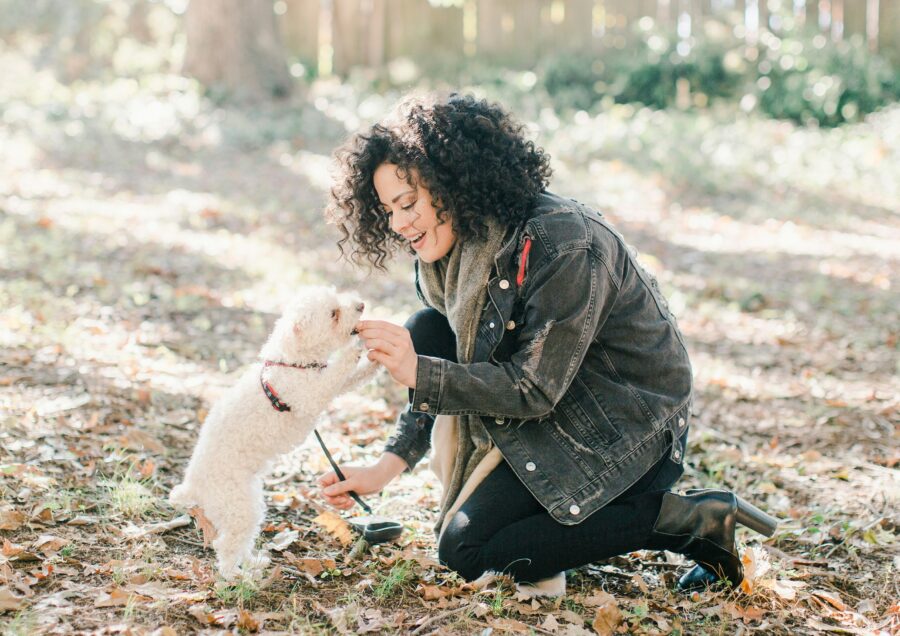Positive reinforcement is a game-changer in dog training. It’s a simple yet powerful method that turns training into an enjoyable experience for your dog and strengthens the bond you share. Let’s explore how to use positive reinforcement in your dog training effectively!
Understanding Positive Reinforcement in Dog Training
Positive reinforcement in dog training involves rewarding your dog for exhibiting desirable behavior. This method encourages the behavior to be repeated and is based on the principle that rewarded behavior is more likely to be repeated. Many professional trainers prefer this technique because it focuses on rewarding good behavior rather than punishing bad behavior, which can often lead to fear and anxiety in dogs.
By using positive reinforcement, you can teach your dog various commands and tricks while ensuring they enjoy the learning process. It’s about making training sessions a positive experience that your dog looks forward to rather than something they dread.
How to Use Positive Reinforcement to Train Your Dog
Positive reinforcement is not just about giving your dog treats; it’s a strategic process that, when done correctly, can yield incredible results. Here’s a step-by-step guide on how to use this method effectively:
- Identify Desired Behaviors
Determine what behaviors you want to encourage. These could include sitting, staying, coming when called, or walking nicely on a leash. Clear goals will help you and your dog focus on what’s important.
- Choose Appropriate Rewards
Select motivating rewards for your dog. These could be their favorite treats, toys, or even simple verbal praise and a good belly rub. The key is to use something that your dog finds rewarding.
- Timing is Key
Reward your dog immediately after they perform the desired behavior. This helps them make a clear association between the behavior and the reward. The quicker the reward follows the behavior, the stronger the association.
- Consistency is Essential
Be consistent with your rewards. Each time your dog performs the desired behavior, they should receive a reward. Over time, this will reinforce the behavior and make it a habit.
- Gradually Phasing Out of Treats
Once your dog has learned the desired behavior, you can gradually reduce the frequency of treats while maintaining verbal praise and other positive reinforcement. This helps make the behavior a permanent part of your dog’s routine without relying solely on treats.
- Incorporate Training into Daily Life
Use everyday opportunities to reinforce training. For example, ask your dog to sit before feeding them or to stay calm before a walk. This makes training a seamless part of your daily interactions.
Is positive punishment effective in dog training?
Positive punishment involves adding an unpleasant stimulus to reduce behavior and is often debated in the dog training community. Examples include loud noises, leash corrections, or verbal reprimands. While these methods can sometimes stop unwanted behavior quickly, they have significant downsides.
Positive punishment can lead to fear, anxiety, and even aggression in dogs. It damages the trust between you and your pet and can make your dog afraid to try new behaviors for fear of being punished. Studies have shown that dogs trained with positive punishment are more likely to exhibit behavioral problems than those trained with positive reinforcement.
Positive reinforcement, on the other hand, builds a strong bond based on trust and mutual respect. It encourages dogs to learn and explore without fear of punishment, leading to happier and more well-adjusted pets.
The Advantages of Positive Reinforcement
Positive reinforcement offers numerous benefits that make it the preferred choice among dog trainers. Here’s why:
- Strengthens Bonds
Rewarding your dog helps build a strong, positive relationship. Your dog learns to associate you with positive experiences, which strengthens your bond.
- Promotes Learning
Dogs trained with positive reinforcement are more eager to learn and respond better to training. They enjoy the process and are likelier to retain what they’ve learned.
- Reduces Behavioral Issues
Positive reinforcement reduces the likelihood of fear and anxiety, which can lead to behavioral issues. It promotes a positive attitude towards learning and behavior modification.
- Adaptable to All Dogs
This method works for dogs of all ages and temperaments. Whether you have a playful puppy or a mature dog, positive reinforcement can be tailored to meet their needs.
Kasten’s Dog Training
At Kasten’s Dog Training, we believe in the power of positive reinforcement to transform your dog’s behavior and enhance your relationship with them. Our expert trainers use proven techniques to teach your dog new behaviors and modify unwanted ones in a positive, supportive environment. We offer a range of training programs, from puppy preschool to advanced obedience and behavior modification, all tailored to meet your dog’s unique needs.
Kasten’s is not just about training dogs; it’s about creating lasting relationships between dogs and their owners. We understand that every dog is different and requires a customized approach to training. Our team is dedicated to providing the best possible experience for you and your dog.
Contact Us Today!
At Kasten’s Dog Training, we are committed to helping you and your dog build a strong, positive relationship through effective training. Visit our website or contact us today to learn more about our services so we can assist you in reaching your training goals!




